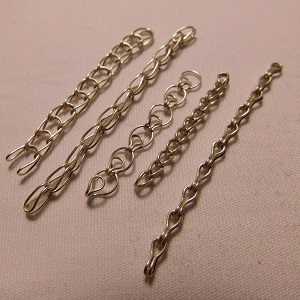
|
One-Sided, Single Loop (1S-1L)
It is called one-sided, one row, or one direction because all the rings orient the same
way in the same axis. It is a single loop because each ring passes through just the previous
link. The foundation of the loop-in-loop technique, everything else just adds more rings to
this building block. It is the most versatile but lacks a deep visual element as a result
of its simplicity. Don't be fooled, however; this one
can have links of any shape and size along with a much more liberal way to attach rings.
18K Gold Necklace: 3/16" I.D., 0.50mm round
Bracelet: 3/16" I.D., 0.50mm round
|
|
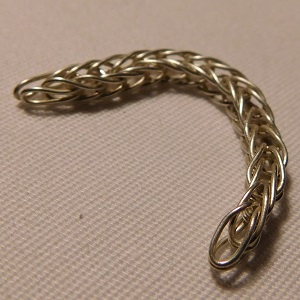
|
One-Sided, Double Loop (1S-2L)
Double loop means each ring passes through two other ones (usually the previous two links but
hybridized weaves throw this aside). It nearly doubles the density of a single loop version.
Link shape will be restricted to some degree but crafty individuals will find ways to experiment.
Bracelet: 1" I.D., 1.5mm round
|
|
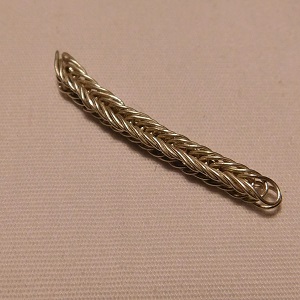
|
One-Sided, Triple Loop (1S-3L)
This will be predisposed to forming a dense, square chain. While many chains of this style are
put through a drawplate to compress them to a uniform round-ish shape, this particular version
would be fine standing on its own. Tools and/or jigs become mandatory to weave the chain with
any precision. Single direction weaves with this many loops begin to show their
sinister nature because the inconsistencies are multiplied as the weave grows in density and length.
It easily turns into a kinked, ugly mess that no drawplate can fix.
|
|
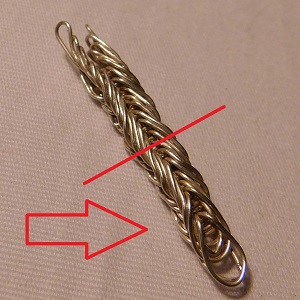
|
One-Sided, Quadruple Loop (1S-4L)
This uses a one-sided, Quadruple Loop starting section about 40% of its length.
Yeah, it's ugly. I don't think these are supposed to be made in this configuration
for this very reason. Anyway, this will be predisposed to forming a flat, rectangular
chain. Due to the increased ring density, tiny variances are a billboard for sloppy
construction as seen in the test piece. They are a thing of beauty that only the
toils of a skilled weaver can make with precision.
|
|
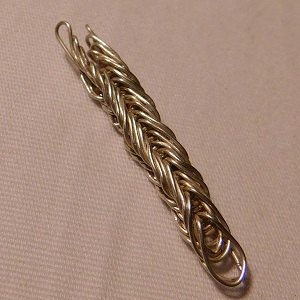
|
One-Sided, Quintuple Loop (1S-5L)
This uses a one-sided, Quadruple Loop starting section about 40% of its length. The rest
is a five loop and it's even uglier! This will be predisposed to forming a flat, rectangular
chain. It's even harder to keep it straight and uniform as seen in the test piece (this
is far from beautiful). Only the toils of a skilled weaver can make them with precision
sans drawplate. Weaves this flat might not be suitable for a round drawplate and I
haven't made a good enough test piece to try it.
|
|
|
|
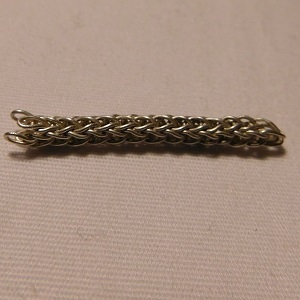
|
Two-Sided, Single Loop (2S-1L)
A classic design, this is two-sided or two directional because the links are oriented in
two different planes (the classic compass directions). It is a single loop because
each new ring passes through the link below it. This makes a beautiful pattern that is closer
to a true rope than just the single direction.
18K Gold Bracelet: 1/4" I.D., 0.50mm round
Bracelet: 3/8" I.D., 0.50mm round
Bracelet: 1" I.D., 1.5mm round
Bracelet: 1/2" I.D., 0.92mm round
Necklace: 1"+ I.D., 1.25mm square
|
|
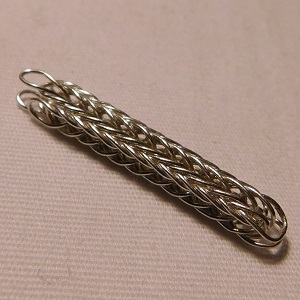
|
Two-Sided, Double Loop (2S-2L)
This could arguably be the poster child for loop-in-loop patterns. The double-sided double
loop has incredible visual perplexity. It is every bit as engaging as a well-done JPL5
or micromaille Half Persian. Woven tightly, this has a rectangular or square profile.
Most, however, are shaped with the drawplate into something akin to a round cord.
18k Gold Bracelet: 3/8" I.D., 0.50mm round
Bracelet: 3/8" I.D., 0.50mm round
|
|
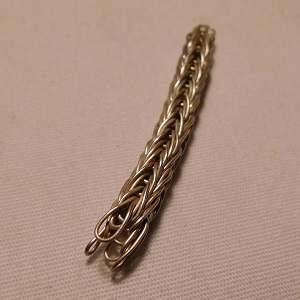
|
Two-Sided, Triple Loop (2S-3L)
For that extra punch and a rounder profile, this one will be a go-to when it needs to be
extra special. Much richer and textured than the two-sided double loop, this will make
some eyes turn. Loop-in-loop weaves of this density often experience a bit of "row
wandering" as links are added. While it all works out in the drawplate for exceptional pieces,
having control over the weave takes a bit more effort.
|
|

|
Two-Sided, Quadruple Loop (2S-4L)
Coming soon.
|
|

|
Two-Sided, Quintuple Loop (2S-5L)
Coming soon.
|
|
|
|
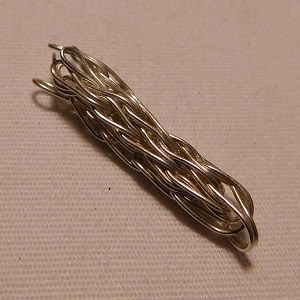
|
Three-Sided, Single Loop (3S-1L)
Moving up to a three-directional chain - links in three planes - really highlights what
this family of weaves can do. The three sides bind together with an airiness that is
deceptive. While there are voids within the interior,
there are so many wires running about that it seems like they are only windows to its soul.
Bracelet: 3/8" I.D., 0.50mm round
Bracelet: ~9/16" I.D., 0.70mm round
Necklace: ~9/16" I.D., 0.75mm round
|
|
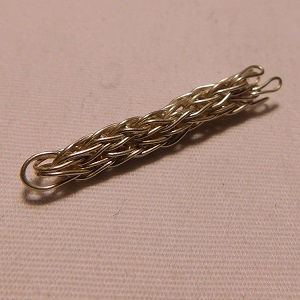
|
Three-Sided, Double Loop (3S-2L)
This one throws down the gauntlet something fierce! Of all the weaves, this one might
be the pinnacle of design. There is only total wonderment. The flowing
striations of metal wire, the harmonious twists and turns, the multipennate construction
are a marvel of precision twisted wire.
|
|
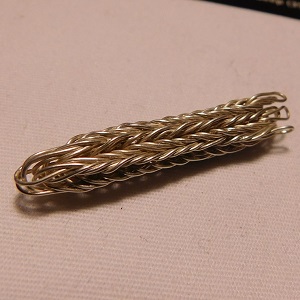
|
Three-Sided, Triple Loop (3S-3L)
This adds a seeming invisible layer of strands somewhere in the fray. The links easily
get bulky and have trouble nesting properly for any number of reasons. But, it makes a
chain that will leave the hardiest of connoisseurs pleased when done properly. With the
expected wire density and thickness inherent in this weave, the smallest piece could be
extruded into a necklace. The tiny wire strands would be reminiscent
of the forging lines on the blade of a Japanese samurai sword.
It is quite rigid when woven with smaller links, perhaps too much for many jewelry applications,
but has interesting characteristics nonetheless.
|
|

|
Three-Sided, Quadruple Loop (3S-4L)
Coming soon.
|
|

|
Three-Sided, Quintuple Loop (3S-5L)
This is a decidedly three-sided, rigid cable that will not be going through any drawplates.
The links are long so even with ultra-thin wire, it may remain quite
stout no matter the wire diameter. It is dense with little air space and takes lots of truing
to make it look right. It certainly resembles a Viking Knit pattern.
It is a structural weave that may never be a flowing, supple, graceful chain.
Perhaps not suitable for a bracelet or necklace, it has desirous properties for other uses.
|
|
|
|
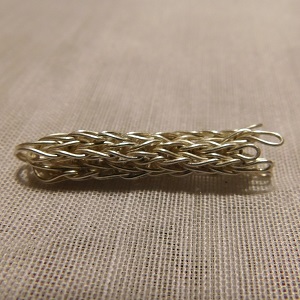
|
Four-Sided, Single Loop (4S-1L)
Each side will fight for the high ground on the outside of the weave as it begins to
get in its own way. It will be thick but still flexible when done properly. And somewhat
heavy compared to all the others.
|
|
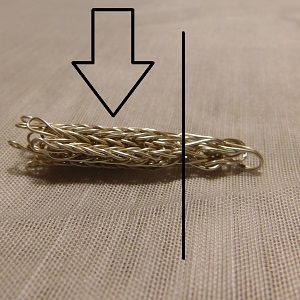
|
Four-Sided, Double Loop (4S-2L)
Even at the smallest size, this starts to become a monster. The individual wires may
not be thick but the resulting cord will be astounding. The majority of any given link
is hidden inside the weave with just the ends sticking out in the familiar loop configuration.
|
|
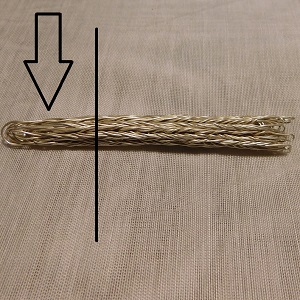
|
Four-Sided, Triple Loop (4S-3L)
Massive. Thick. The thinnest wire will make a logic-defying hefty rope. The length of wire needed for a small
section will scare your wallet. A 15" choker will need thousands of rings, which means it'll have some
mass to it, use untold feet of wire, and be 1/2" thick!
Delicate might not be the best word to describe it. The practicality begins to wane as it is essentially a rod.
|
|
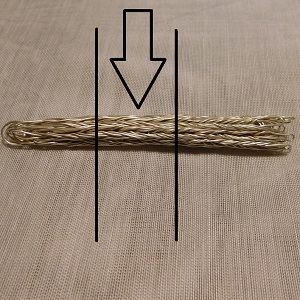
|
Four-Sided, Quadruple Loop (4S-4L)
Super massive and thick. Utterly amazing. The amount of wire needed will
be prohibitive. The test weave starts as a 4-in-3, then to a 4-in-4, and then 4-in-5.
It is very difficult to keep the sides aligned and protruding as they should; more isn't
always better with loop-in-loop chains.
|
|
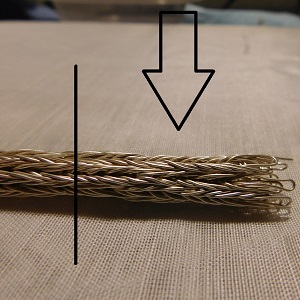
|
Four-Sided, Quintuple Loop (4S-5L)
Super duper massive and thick. Beyond amazing. Call the wire mill because making
any length uses ridiculous amounts of wire! The
test weave starts as a 4-in-3, then to a 4-in-4, and then 4-in-5. It is very difficult to keep the
sides aligned as they should; more isn't always better with loop-in-loop chains.
This is an inflexible behemoth that probably couldn't be used for anything jewelry but I will
experiment further and see what happens.
|